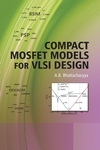Jul 17, 2009
Lynguent Debuts Radiation Hardened By Design, BSIM4 Compact Model Toolkits
Read more...
Jul 7, 2009
New Book:

Compact MOSFET Models for VLSI Design
A. B. Bhattacharyya
ISBN: 978-0-470-82342-2
Hardcover 512 pages April 2009
This book is essential for students specializing in VLSI Design and indispensible for design professionals in the microelectronics and VLSI industries. Written to serve a number of experience levels, it can be used either as a course textbook or practitioner’s reference. Read more...
Access the MATLAB code, solution manual, and lecture materials at the companion website.
Jul 3, 2009
IC Insights expects an 18% "surge" in the IC market
I post here a very interesting article, even if not related to compact modelling, from EDN:(visit them for more interesting articles)
IC market second-half 'surge' predicted
IC Insights expects an 18% "surge" in the IC market in the second half of the year and claims there is clear evidence that the much-anticipated turning point toward recovery has already occurred.
By Suzanne Deffree, Managing Editor, News -- Electronic News, 7/2/2009
The second half of 2009 will be much better than the first for the semiconductor industry, and will be marked by an IC market "surge," according to IC Insights.
The market research company this week reported that while the first half of 2009 was hit hard by seasonal weakness for electronic system sales, a major IC inventory adjustment, and the global recession at its worst, the second half of 2009 is expected to usher in strong seasonal strength for electronic system sales, a period of IC inventory replenishment, and positive worldwide GDP growth.
"In IC Insights' opinion, the bottom of the current cycle in the worldwide economy and semiconductor industry was reached in Q1 2009," Bill McClean, president of IC Insights, said in a statement on the company's mid-year update. "While the 'velocity' of the semiconductor industry recovery is subject to debate (slow, moderate, fast, etc), at least the discussion over the next few quarters will be about how much sequential growth can be expected in instead of how far the markets are going to fall."
|
For example, according to the company's data, worldwide GDP growth is forecast to be negative this year of down 0.8% on a weak first half with growth down, but the second half of the year is expected to register positive growth of 2%. (See figure 1 below.) The same pattern is forecast for the US economy, as well, with the second half showing growth of 1.3% as compared to the first half.
Specific to the electronics industry, IC Insights reported seasonal strength is likely to propel second-half cell phone and PC unit shipments up by 18% and 15%, respectively, as compared to the first half.
Overall, IC Insights said it expects an 18% "surge" in IC market sales in the second half, as compared to the first half. "In fact, the double-digit Q2 2009/Q1 2009 IC market increase is clear evidence of the fact that the much-anticipated turning point has already occurred," McClean said.
According to IC Insights, the IC foundry market is expected to continue its "sharp recovery" in the second half of 2009. McClean noted that the IC foundry market almost doubled in Q2 as compared to Q1.
"There is no doubt that, as a group, the semiconductor equipment suppliers have taken the worst 'beating' of any of the companies involved in the current semiconductor industry downturn," McClean said. "However, the second half of 2009 is expected to offer some relief for these suppliers as semiconductor industry capital spending is forecast to jump by 28% as compared to the first half of 2009."
McClean noted that many of the major semiconductor suppliers that IC Insights tracks are planning to spend the majority of their capital spending budgets in the second half of 2009. Offering example, he said Hynix spent 30% of its 2009 spending budget in the first half, but plans to spend the remaining 70% in the second half.

Jun 30, 2009
Old glories never die... do they?
SMIC Deploys Synopsys HSPICE Simulator for 45-nm Physical IP and Standard Cell Development (Synopsys)
Have a nice summertim
Jun 18, 2009
An Insider’s View to the Swiss LP/LV CMOS Design History
Host: Predrag Habas; EM Marin
Where: EPFL - Swiss Federal Institute of Technology, Lausanne, Room CO017
When: Friday, July 3, 2009, 5:00 pm
Title: An Insider’s View to the Swiss LP/LV CMOS Design History
Presenter: Stefan Cserveny
QUCS developments
Read more...
The QUCS Team is also contributing to the MIXDES special session "Device Level Support for Emerging CMOS Technologies" organised by Daniel Tomaszewski; ITE, Poland and Wladek Grabiński; GMC Suisse (with MOS-AK/GSA Group and COMON EU Project coordination)
Read the QUCS paper's abstract: "Compact Device Modeling for Established and Emerging Technologies with the Qucs GPL Circuit Simulator"
Future Solutions of System On Chip (SoC)
View the slide presentation...
